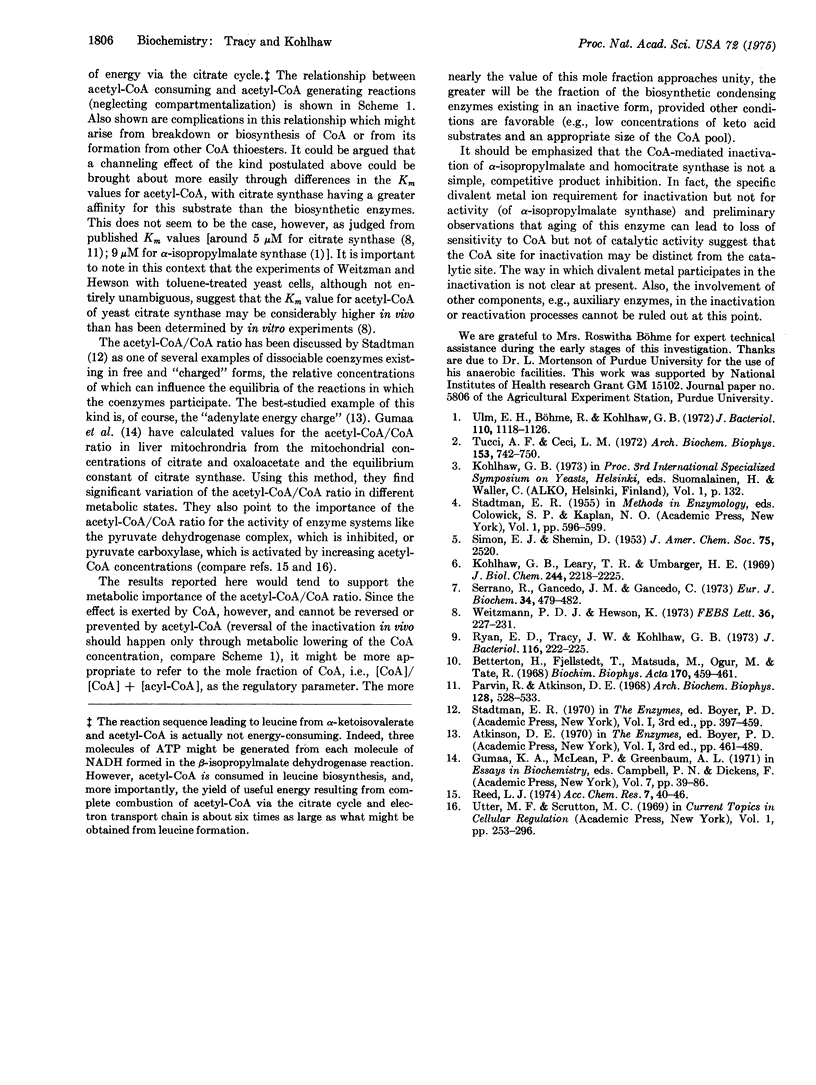Abstract
alpha-Isopropylmalate synthase [3-hydroxy-4-methyl-3-carboxyvalerate 2-oxo-3-methylbutyrate-lyase (CoA-acetylating); EC 4.1.3.12], the enzyme catalyzing the first committed step in leucine biosynthesis, and homocitrate synthase [3-hydroxy-3-carboxyadipate 2-oxoglutarate-lyase (CoA-acetylating); EC 4.1.3.21], the first enzyme in lysine biosynthesis in yeast, are rapidly inactivated in the presence of low concentrations of coenzyme A, a product of both reactions. Closely related compounds like 3-dephospho-coenzyme A or oxidized coenzyme A are almost without effect, as are other sulfhydryl compounds. Citrate (si)-synthase [citrate oxaloacetate-lyase (pro-3S-CH2-COO-minus leads to acetyl-CoA); EC 4.1.3.7] appears to be completely resistant against inactivation by coenzyme A. Inactivated alpha-isopropylmalate and homocitrate synthases can be reactivated by dialysis, but not by adding excess substrate. Protection against coenzyme-A-mediated inactivation is provided by relatively high concentrations of the alpha-ketoacid substrate or the specific end product inhibitor of each of the two enzymes. The coenzyme-A-mediated inactivation of alpha-isopropylmalate synthase has been more closely investigated. It requires the presence of divalent metal ions, with Zn++being most effective. The inactivation does not require molecular oxygen. It occurs in the presence of low concentrations of substrates and is observed in toluene-treated cells. These results, together with evidence that alpha-isopropylmalate synthase and homocitrate synthase are located in the mitochondria, suggest a mechanism by which increasing intra-mitochondrial coenzyme A concentrations might serve as a signal of decreasing acetyl-coenzyme A levels, triggering a temporary inactivation of biosynthetic acetyl-coenzyme A-consuming reactions in order to channel the available acetyl-coenzyme A into the citrate cycle.
Full text
PDF




Selected References
These references are in PubMed. This may not be the complete list of references from this article.
- Betterton H., Fjellstedt T., Matsuda M., Ogur M., Tate R. Localization of the homocitrate pathway. Biochim Biophys Acta. 1968 Dec 23;170(2):459–461. doi: 10.1016/0304-4165(68)90036-6. [DOI] [PubMed] [Google Scholar]
- Kohlhaw G., Leary T. R., Umbarger H. E. Alpha-isopropylmalate synthase from Salmonella typhimurium. Purification and properties. J Biol Chem. 1969 Apr 25;244(8):2218–2225. [PubMed] [Google Scholar]
- Parvin R., Atkinson D. E. Purification and some properties of yeast citrate synthase. Arch Biochem Biophys. 1968 Nov;128(2):528–533. doi: 10.1016/0003-9861(68)90060-x. [DOI] [PubMed] [Google Scholar]
- Ryan E. D., Tracy J. W., Kohlhaw G. B. Subcellular localization of the leucine biosynthetic enzymes in yeast. J Bacteriol. 1973 Oct;116(1):222–225. doi: 10.1128/jb.116.1.222-225.1973. [DOI] [PMC free article] [PubMed] [Google Scholar]
- Serrano R., Gancedo J. M., Gancedo C. Assay of yeast enzymes in situ. A potential tool in regulation studies. Eur J Biochem. 1973 May 2;34(3):479–482. doi: 10.1111/j.1432-1033.1973.tb02783.x. [DOI] [PubMed] [Google Scholar]
- Tucci A. F., Ceci L. N. Homocitrate synthase from yeast. Arch Biochem Biophys. 1972 Dec;153(2):742–750. doi: 10.1016/0003-9861(72)90393-1. [DOI] [PubMed] [Google Scholar]
- Ulm E. H., Böhme R., Kohlhaw G. Alpha-isopropylmalate synthase from yeast: purification, kinetic studies, and effect of ligands on stability. J Bacteriol. 1972 Jun;110(3):1118–1126. doi: 10.1128/jb.110.3.1118-1126.1972. [DOI] [PMC free article] [PubMed] [Google Scholar]
- Weitzman P. D., Hewson J. K. In situ regulation of yeast citrate synthase. Absence of ATP inhibition observed in vitro. FEBS Lett. 1973 Oct 15;36(2):227–231. doi: 10.1016/0014-5793(73)80374-6. [DOI] [PubMed] [Google Scholar]


